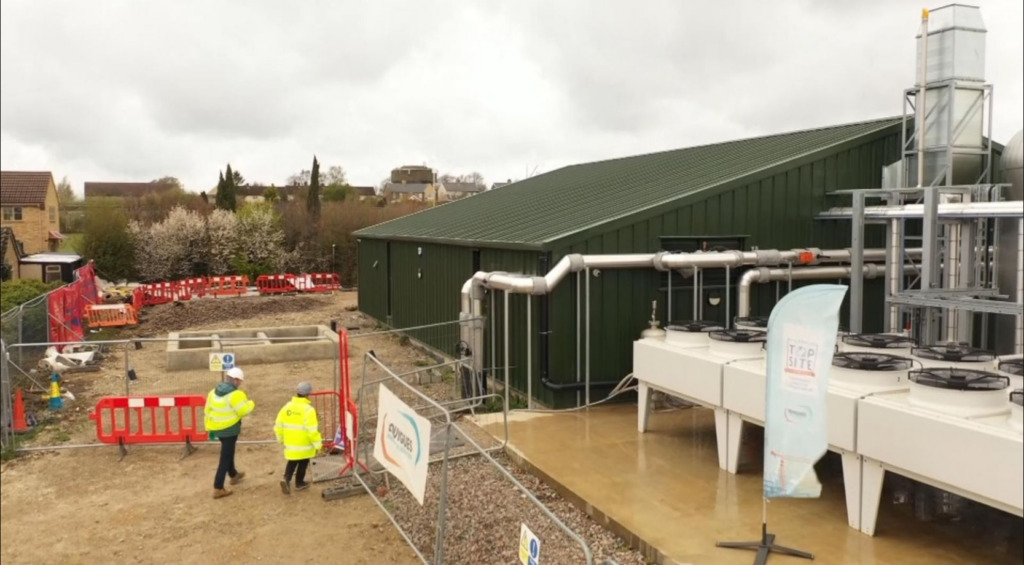
The fuel supply to Mike Brewer’s home in the Cambridgeshire village of Swaffham Prior has been cut off.
The pipe was severed in December. Without gas or oil, his radiators are still warm. The heat is transported from a field on the outskirts of the village.
“My ancient oil tank is located next to the home. I attempt to conceal it with vegetation, but I cannot wait to have it removed.”
The majority of the green home heating discussion we’ve heard thus far has centered on the choice between heat pumps and hydrogen boilers. The concept of piping hot water to people’s residences from a central heat source feels a bit foreign, reminiscent of Berlin during the Soviet era.
However, it is a vast underutilized energy resource, and modern systems give homeowners such as Mike total control.
“This is exactly how you would typically heat your property. It simply transfers the heat from a boiler system to hot water that emerges from a pipe in the earth.

There is a thermostat in the living room that can be adjusted like any other heating system.
The majority of electricity is generated by boiling water with fuel to create steam. This steam then drives a turbine, while most of the heat is lost to the atmosphere via the enormous cooling structures that surround power plants.
It is estimated that Europe’s industrial and power plant waste heat is equivalent to France’s total energy consumption or the Netherlands’ waste heat.
Currently, only 2% of British households are connected to heat networks, compared to 12% in the EU. However, Andrea Voight, director of public affairs for the low-carbon engineering company Danfoss, asserts that there is a great deal more potential.

“I believe district heating has a wonderful and promising future, but it is not currently being utilized. Half of Europe’s ultimate energy consumption is for heating and cooling.
“However, there is still a vast amount of excess heat from power and industry that is not being used and is simply being released into the atmosphere.”
However, hot water conduits are compatible with any central heat source. Heat pumps, such as the one close to Mike Brewer’s home in Swaffham Prior, are the most environmentally responsible.
Here, a collaboration between Cambridgeshire County Council and Bouygues Energies and Services resulted in the construction of a £12 million energy facility with both ground and air source heat pumps.
Currently, these are powered by the grid, but by summer they will be almost exclusively powered by a nearby solar farm. Currently, fifteen residences are linked to this system, but 300 are planned.

The project’s developer, Emma Fletcher, stated, “This is a hot water system. We are heating water to 75 degrees, and then pumping it to people’s residences throughout the village.
A water system keeps homes’ moist central heating systems running smoothly.
Although expensive to construct, these heat pump-based networks could be appealing to the 1,100,000 primarily rural homes that are still dependent on oil despite being off the gas grid.

But what about utilizing the excess heat produced by all these existing power plants? Next to the Millwall Football Club stadium in southeast London is a massive energy from waste facility.
It is operated by Veolia and consumes non-recyclable waste to generate electricity. Some of the excess heat is distributed to 2,000 nearby residences, and there are plans to connect 18,000 more.
Using their heat, however, reduces emissions elsewhere because connected households use their own boilers significantly less or may not require one at all. Domestic gas furnaces are supposed to be phased out in Britain, but they are still being installed, and it is estimated that a new boiler is installed every eight seconds in the European Union.
Tommy Folliard, director of energy recovery operations, stated, “This is a low carbon solution because it eliminates the need to heat those homes with fossil fuels such as gas. And energy from waste plants eliminates the need to landfill this refuse.”
Despite the fact that energy from waste facilities reduce landfill, they still emit a significant amount of CO2 and raise concerns about local air pollution.
At a time when fossil fuels are scarce, polluting, and costly, it seems illogical to allow so much of their energy to escape up chimneys.
